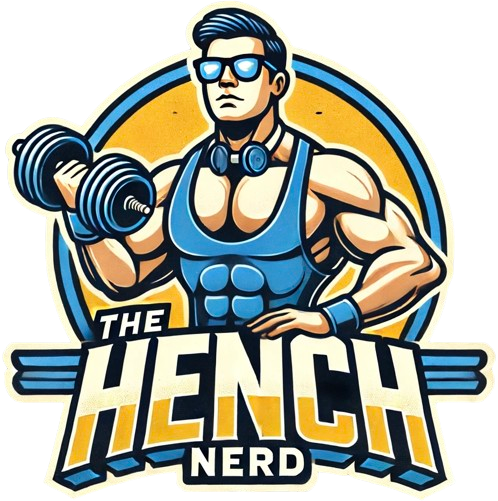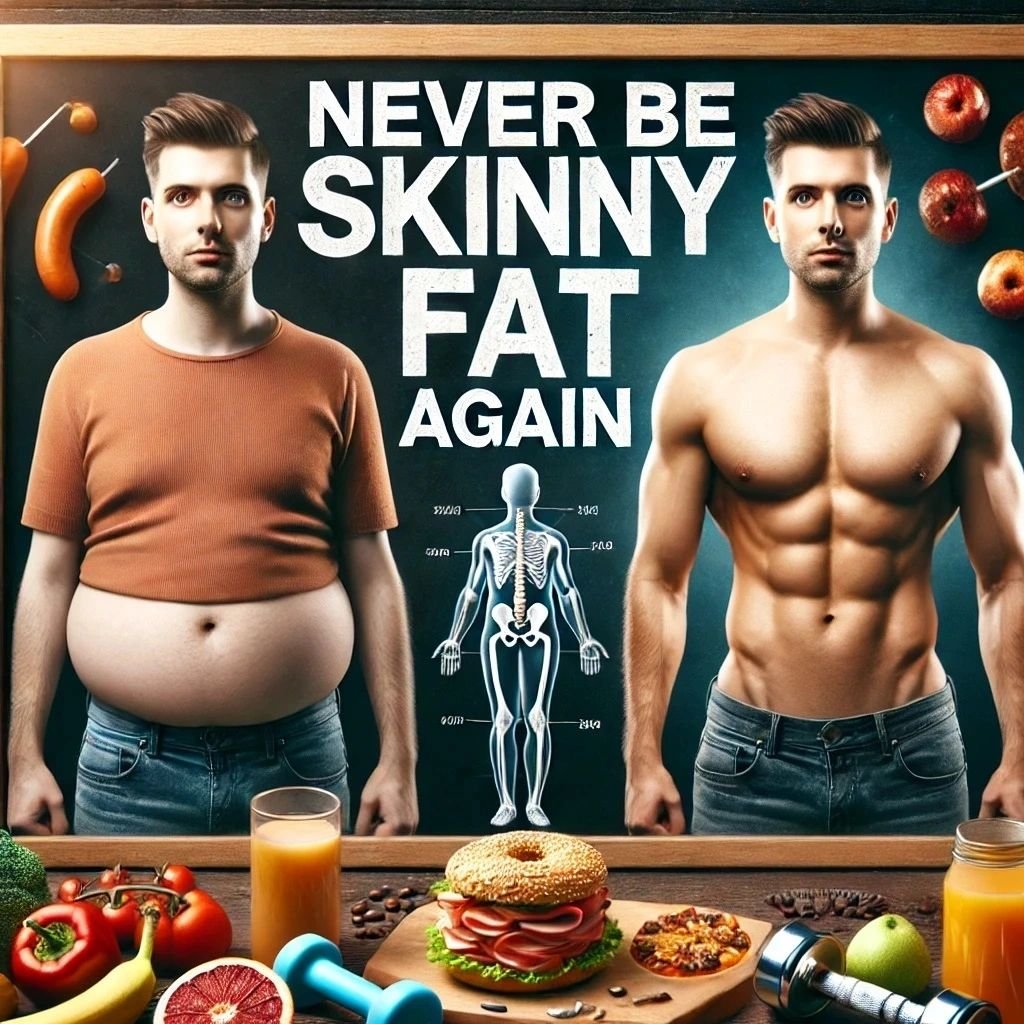Have you ever looked in the mirror and felt frustrated by a soft, undefined physique despite being relatively slim? You’re not alone! The skinny fat phenomenon affects countless individuals, but here’s the good news – it’s entirely beatable and rather easy to understand. Once you beat it, welcome to your lean and muscular physique.
In fact, a study by the American Council on Exercise found that targeted resistance training can increase muscle mass by up to 3.1 pounds in just 8 weeks, even in beginners. Imagine what that could do for your physique! I’ve been there myself, and let me tell you, it’s no fun feeling like you’re stuck in fitness limbo. When I started strength training many moons ago (feels like eons now), I looked like a relatively slim child, but shirtless, my chest looked a little flabby, and there wasn’t an ab in sight.
Dr. Stuart Phillips, a leading researcher in muscle protein synthesis, highlights that resistance training, when combined with adequate protein intake, can effectively stimulate muscle growth. He explains that “resistance training increases muscle protein synthesis rates, particularly when dietary protein intake is optimised.”
In this comprehensive guide, we’ll dive into the root causes of being skinny fat and arm you with proven strategies to transform your body. Get ready to say goodbye to skinny fat and hello to a lean and muscular you!
Fat Loss and a Bit of Muscle Gain Is What Stands Between You and Eliminating Skinny Fat
Contents
- What Is Skinny Fat and How to Transform It
- Nutrition Strategies to Beat Skinny Fat and Build a Lean and Muscular Physique
- Body Recomposition: The Newbie Advantage
- Resistance Training: Your Secret Weapon Against Skinny Fat
- Cardio for Skinny Fat: Friend or Foe?
- Lifestyle Factors That Influence Your Skinny Fat Transformation
- Tracking Your Progress: Tools and Tips
- Hormonal Imbalances and Their Impact on Skinny Fat
- Common Mistakes to Avoid During Your Skinny Fat Transformation
- Supplements: Separating Fact from Snake Oil
- Conclusion: Achieving a Lean and Muscular Body
Top 8 FAQs About Beating Skinny Fat
1. What does “skinny fat” mean?
Skinny fat describes someone who appears slim but has a high body fat percentage relative to muscle mass, resulting in a soft, undefined physique. It’s caused by too little muscle and excess body fat.
2. How do I fix skinny fat?
The solution is straightforward: build muscle and lose fat. This involves strength training, eating a balanced diet high in protein, and maintaining a slight calorie deficit to support fat loss while preserving muscle.
3. What’s the best type of workout for skinny fat?
Resistance training is key, especially focusing on compound exercises like squats, deadlifts, bench presses, and pull-ups. These movements engage multiple muscle groups and help build strength and definition.
4. Should I do cardio to fix skinny fat?
Cardio can help with fat loss but should be secondary to strength training. Opt for HIIT (High-Intensity Interval Training) to burn fat efficiently while preserving muscle. Avoid excessive steady-state cardio, which can lead to muscle loss.
5. How does nutrition play a role in fixing skinny fat?
Nutrition is crucial. Eat at or slightly below maintenance calories, prioritise 1 gram of protein per pound of body weight, and balance carbs and fats based on personal preference. Whole, nutrient-dense foods should form the core of your diet.
6. What’s the “newbie advantage” in fixing skinny fat?
Beginners can simultaneously burn fat and build muscle—a process called body recomposition. Early strength training triggers rapid gains in muscle mass and fat loss, making this the best time to transform your physique.
7. Do supplements help with skinny fat?
Most are unnecessary, but creatine is highly effective for boosting strength and muscle growth. Protein powder is helpful if you struggle to hit daily protein targets. Avoid “fat-burning” pills—they’re usually ineffective and overhyped.
8. How long does it take to fix skinny fat?
It depends on your starting point, but with consistent training and nutrition, you can see noticeable changes in 8–12 weeks. Long-term results come with sustained effort and patience.
What Is Skinny Fat and How to Transform It
First things first – what exactly is “skinny fat“?
It’s a term used to describe individuals who appear thin or have a “normal” BMI but carry a high percentage of body fat relative to their muscle mass. This can result in a soft, undefined appearance, even if you’re not overweight by traditional standards.
Your weight on the scales doesn’t tell the whole story. You could be within a “healthy” weight range but still have a higher-than-ideal body fat percentage. This is where the importance of body composition and recognising that BMI is a broken measurement comes into play. It’s not just about how much you weigh, but what that weight is made up of – muscle, fat, bone, and water.
Simply put – you’re carrying too little muscle and a higher-than-average body fat percentage. You simply need to lose fat and gain some muscle. Hey presto, you now understand what’s needed for a skinny fat transformation to achieve a lean and muscular physique.
Nutrition Strategies to Beat Skinny Fat and Build a Lean and Muscular Physique

Now that we understand what we’re dealing with, let’s talk about one of the most crucial aspects of beating skinny fat – nutrition. You’ve probably heard the saying, “You can’t out-train a bad diet,” and it’s absolutely true!
The key to transforming your body composition lies in a balanced, whole-food diet. Here’s what you need to focus on:
- Calculate your optimal calorie intake: To build muscle and lose fat simultaneously (a process called body recomposition), you’ll need to eat at or slightly below maintenance calories.
- Example: if you weigh 187 lbs, multiply it by 14 (187 x 14 = 2618 calories per day). If your body fat isn’t decreasing, lower the multiplier to 13.
- Prioritise protein: Aim for 1 gram per pound of body weight daily. This supports muscle growth and recovery.
- Split fat and carbs as preferred: I do better splitting carbs and fat evenly on resistance days and going lower carb on non-lifting days.
Body Recomposition: The Newbie Advantage
One of the biggest benefits of starting your skinny fat transformation is what’s known as the newbie advantage. This term refers to the rapid progress beginners can make when they start strength training, particularly if they’ve never done any serious weightlifting before.
When you’re new to weight training, your body responds incredibly well to even the most basic movements. Your muscles haven’t been exposed to resistance before, so they grow quickly in response to the stimulus. Here’s why you can expect rapid gains as a newbie:
- Neurological Adaptations: Your body’s nervous system learns to recruit more muscle fibres when you train. This makes you stronger almost instantly, even before your muscles start to grow.
- Increased Insulin Sensitivity: Your body becomes more efficient at using the carbohydrates you consume for fuel, which supports both fat loss and muscle growth.
- Hormonal Response: Beginners experience a spike in anabolic hormones like testosterone and growth hormone, which helps build muscle faster than more experienced lifters.
Newbies have the advantage of body recomposition, where you can burn fat and gain muscle simultaneously, something much harder to achieve for advanced trainees. Make the most of this window by focusing on consistent, progressive training and a solid nutrition plan.
Resistance Training: Your Secret Weapon Against Skinny Fat
If you want to say goodbye to skinny fat and hello to a lean and muscular physique, resistance training is your secret weapon. Resistance training, also known as weightlifting or strength training, provides the stimulus your body needs to build and maintain muscle mass. The more muscle you have, the higher your metabolic rate, meaning you burn more calories at rest, which helps shed body fat and gives you that lean and muscular look.
Why Resistance Training Works So Well
- Increased Metabolic Rate: Muscle is more metabolically active than fat, meaning the more muscle you build, the more calories your body burns even when you’re resting. This is crucial for combating skinny fat because it helps burn off excess body fat while building a more defined physique.
- Muscle Definition: You can do all the cardio in the world, but without resistance training, you won’t achieve that firm, muscular look. Resistance training helps sculpt your body, giving you definition and making your muscles more prominent.
- Long-Term Fat Loss: Unlike dieting alone, resistance training ensures that the weight you lose is fat, not muscle. Without it, you risk losing muscle mass, which could worsen your skinny fat appearance.
Focus on Compound Exercises
To maximise your time in the gym, your focus should be on compound exercises. These are movements that engage multiple muscle groups at once, making them more effective for building muscle and burning calories. Here are the key compound exercises to include in your routine:
- Squats/leg press/ lunges: These work your legs
- Deadlifts/ trap bar deadlifts: Engages your entire posterior chain, from your hamstrings to your traps.
- Bench Press/dumbbell press/ dips/ shoulder press: Targets your chest, shoulders, and triceps.
- Pull-Ups/Rows: Work your lats, back, biceps, and shoulders.
Compound exercises are more effective than isolation exercises (like bicep curls) because they involve more muscle groups and burn more calories in less time. They’re your ticket to a lean and muscular physique.
This isn’t too say isolation exercises are useless – just prioritise compound movements at the beginning of your workout. You can read my rest-pause and mind muscle articles for greater clarity and context on this muscle building journey.
Progressive Overload: The Key to Consistent Muscle Growth
Progressive overload is the principle of gradually increasing the weight, reps, or intensity of your workouts over time to continually challenge your muscles. This is essential for building muscle and strength.
- Start Small: If you’re new to lifting, start with light weights and focus on perfecting your form. Once your form is solid, start adding weight to your exercises.
- Track Your Progress: Keep a workout log to track how much weight you’re lifting each week. Aim to add a small amount of weight or increase the number of reps or sets each week.
- Stay Consistent: Muscle growth doesn’t happen overnight, but with consistent progressive overload, you’ll steadily get stronger and build muscle, banishing that skinny fat look.
You certainly don’t need hours in the gym. How to save time in the gym? Work hard and follow a great program.
Cardio for Skinny Fat: Friend or Foe?

Cardio has its place, but when your goal is to transition from skinny fat to lean and muscular, cardio needs to be managed carefully. While cardio can help with fat loss, doing too much of it can interfere with muscle growth.
Prioritise HIIT (High-Intensity Interval Training)
HIIT is the perfect cardio option for those looking to get lean without sacrificing muscle. HIIT involves short bursts of intense exercise followed by rest periods. Not only does HIIT torch calories during the workout, but it also boosts your metabolism for hours afterward.
- Efficient Fat Loss: Just 20-30 minutes of HIIT a few times a week is enough to burn fat without overdoing it.
- Muscle Preservation: Unlike long-duration cardio, HIIT helps preserve muscle mass because the short bursts of high effort don’t lead to excessive muscle breakdown.
Limit Steady-State Cardio
While steady-state cardio (like jogging or cycling at a consistent pace) can improve cardiovascular health, too much of it can cause muscle loss, especially if paired with a calorie deficit. If you enjoy steady-state cardio, limit it to 2-3 times per week, and always prioritise your resistance training. You can find many articles on HIIT/steady state cardio within my ultimate guide to fitness post.
Lifestyle Factors That Influence Your Skinny Fat Transformation

Sleep: The Muscle Builder You Can’t Skip
Many people underestimate the importance of sleep in their fitness journey. Sleep is when your body recovers and repairs the muscles you’ve worked during the day. Without enough quality sleep, your body’s ability to build muscle and burn fat takes a significant hit.
- Aim for 7-9 Hours: This is the sweet spot for most people to allow for muscle recovery and optimal hormonal balance.
- Create a Sleep Routine: Going to bed and waking up at the same time every day helps regulate your body’s natural rhythms, improving sleep quality.
Stress Management: Keep Cortisol in Check
Stress has a direct impact on your body composition. When you’re stressed, your body produces cortisol, a hormone that can lead to fat storage, especially around the belly.
- Practice Mindfulness: Activities like meditation, yoga, or even taking regular walks can help reduce stress and lower cortisol levels.
- Stay Active: Exercise itself is a great stress reliever, so make your gym time a priority, not just for your muscles but for your mental health.
Hormonal Imbalances and Their Impact on Skinny Fat
For men over 40, hormonal changes can be a significant factor in the skinny fat phenomenon. As we age, testosterone levels decline, and cortisol (the stress hormone) levels can increase, making it harder to lose fat and build muscle.
Testosterone Levels and Muscle Mass
Testosterone is the primary hormone responsible for muscle growth and fat loss in men. As testosterone levels naturally decline with age, it becomes harder to build muscle, which is why older men often struggle with the skinny fat physique.
- Boost Testosterone Naturally: Strength training, especially heavy compound exercises, has been shown to boost testosterone levels. In addition, getting enough healthy fats from sources like avocados, meat and nuts can help support hormonal health. You can learn all about how I naturally increased my testosterone levels here.
Cortisol and Fat Storage
Cortisol, the body’s primary stress hormone, can lead to fat storage, especially around the belly. High cortisol levels also interfere with muscle recovery and growth.
- Reduce Stress: Incorporate stress management techniques like mindfulness, yoga, or even just daily walks to keep cortisol levels in check.
- Prioritise Rest and Recovery: Overtraining can increase cortisol levels, so make sure you’re balancing your workouts with adequate rest and recovery.
Supplements: Separating Fact from Snake Oil
The supplement industry is full of promises, but most supplements marketed for fat loss or muscle gain are little more than snake oil. Here’s the truth:
Protein Powder
Protein powder can be useful, but only if you’re not getting enough protein from whole foods. If you’re hitting your daily protein target with real food, there’s no need to rely on protein powder.
Creatine
Does creatine work? Unlike most supplements, creatine is well-researched and proven to enhance muscle growth and performance. Studies show that it increases strength, improves endurance, and helps with muscle recovery. Creatine is one of the few supplements that lives up to its claims.
The Snake Oil Industry
The majority of fat-burning pills, muscle-building formulas, and recovery boosters are snake oil. These products lack scientific backing and often contain misleading ingredients. Focus on a whole-food diet and proper training, and skip the supplements promising overnight results.
Don’t Fall for Gimmicks: Simple Doesn’t Mean Easy

In today’s bro science riddled fitness world, it’s easy to get overwhelmed by the noise from influencers and so-called “quick fixes.” You’ll find endless products, diet plans, and supplements claiming to eliminate skinny fat overnight. But here’s the truth – getting rid of skinny fat is simple, but that doesn’t mean it’s easy.
Many influencers will push fancy workout routines or promote the latest fad diet (Hollywood isn’t immune from this), but the science behind fat loss and muscle gain hasn’t changed. The body is very simple in the way it loses fat and builds muscle. All you need to do is lose body fat while gaining muscle and getting stronger. This is the key to going from skinny fat to lean and muscular.
Quick fixes and shortcuts are tempting, but they often leave you spinning your wheels. To transform your body, you need to focus on the basics: follow a structured strength training program, eat the right amount of calories for your goal, and fuel your body with adequate protein. The process takes time, but with consistency, the results will come.
Common Mistakes to Avoid During Your Skinny Fat Transformation
- Overtraining: More isn’t always better.
- Crash diets: Extreme calorie restriction can lead to muscle loss.
- Neglecting recovery: Don’t skip rest days – they’re when muscle growth happens.
- Comparing yourself to others: Everyone’s journey is different.
Conclusion: Achieving a Lean and Muscular Body
There you have it! You’re now armed with the knowledge and strategies to kick skinny fat to the kerb once and for all. From understanding body recomposition to focusing on compound exercises and incorporating HIIT, you have all the tools you need for a successful transformation.
Remember, transforming your physique is a journey, not a sprint. Stay consistent with your nutrition and training, and trust in these science-backed methods. Each step brings you closer to the lean and muscular body you desire.
Chat soon,
Matt


3 thoughts on “How to Never be Skinny Fat Again: Your Lean and Muscular Guide”
Comments are closed.